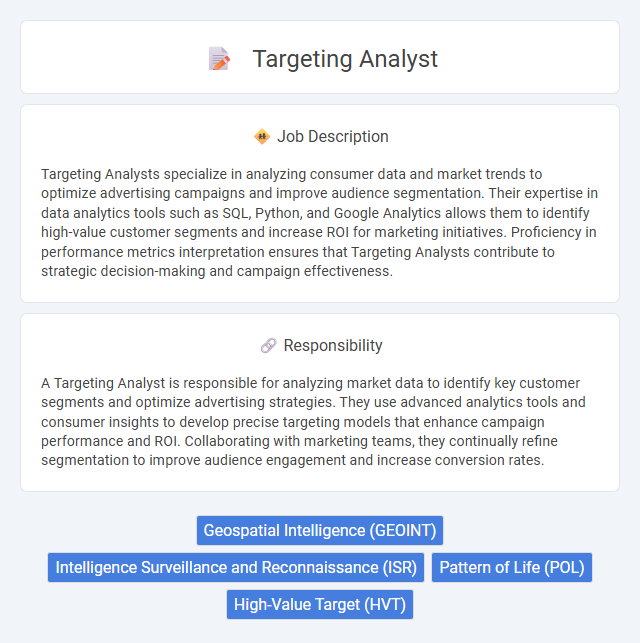
Targeting Analysts specialize in analyzing consumer data and market trends to optimize advertising campaigns and improve audience segmentation. Their expertise in data analytics tools such as SQL, Python, and Google Analytics allows them to identify high-value customer segments and increase ROI for marketing initiatives. Proficiency in performance metrics interpretation ensures that Targeting Analysts contribute to strategic decision-making and campaign effectiveness.
Individuals with strong analytical skills and a keen attention to detail are likely suitable for a Targeting Analyst role, as the job demands precise data interpretation and strategic thinking. Those who enjoy working with complex datasets and possess proficiency in statistical tools may find it a good fit, while candidates lacking these skills or an interest in quantitative analysis might struggle. The position probably suits people who can adapt to fast-paced environments and collaborate with cross-functional teams to optimize targeting strategies.
Qualification
Targeting Analysts require strong analytical skills and proficiency in data analysis tools such as SQL, Python, and Excel to extract actionable insights from complex datasets. A background in marketing, statistics, or data science, often supported by a bachelor's degree or higher, is essential for interpreting market trends and consumer behavior effectively. Experience with customer segmentation, predictive modeling, and digital advertising platforms like Google Ads or Facebook Business Manager enhances the ability to optimize campaign targeting and maximize ROI.
Responsibility
A Targeting Analyst is responsible for analyzing market data to identify key customer segments and optimize advertising strategies. They use advanced analytics tools and consumer insights to develop precise targeting models that enhance campaign performance and ROI. Collaborating with marketing teams, they continually refine segmentation to improve audience engagement and increase conversion rates.
Benefit
Targeting Analysts likely enhance marketing campaigns by improving audience segmentation, which can increase conversion rates and reduce advertising costs. Their work probably supports better resource allocation, leading to higher return on investment for marketing budgets. Companies may benefit from more precise targeting strategies that drive sales growth and customer retention.
Challenge
Targeting Analyst roles likely present challenges related to interpreting complex data sets to accurately identify key audience segments. The need to continually adapt to evolving market trends and consumer behaviors probably requires a strong analytical mindset and flexibility. Balancing precision in targeting with efficiency in campaign execution may also pose ongoing difficulties.
Career Advancement
Targeting Analyst roles involve analyzing consumer data and market trends to optimize marketing strategies, which builds expertise valuable for advancing into senior analyst or marketing manager positions. Mastery of data analytics tools and experience in cross-functional collaboration enhance career growth opportunities within digital marketing firms and advertising agencies. Proactive skill development in predictive modeling and audience segmentation can accelerate progression to strategic roles like campaign director or data science lead.
Key Terms
Geospatial Intelligence (GEOINT)
Targeting Analysts specializing in Geospatial Intelligence (GEOINT) analyze satellite imagery, geographic data, and spatial information to identify and track enemy movements and strategic targets. They utilize advanced GIS software and remote sensing technologies to deliver precise intelligence for mission planning and threat assessment. Expertise in interpreting multispectral and hyperspectral data enhances targeting accuracy and supports timely decision-making in military operations.
Intelligence Surveillance and Reconnaissance (ISR)
A Targeting Analyst specializing in Intelligence, Surveillance, and Reconnaissance (ISR) leverages advanced analytics and geospatial data to identify and prioritize high-value targets. The role requires proficiency in processing multispectral ISR inputs, including signals intelligence (SIGINT), human intelligence (HUMINT), and imagery intelligence (IMINT), to create actionable intelligence reports. Expertise in threat assessment, pattern recognition, and collaboration with joint operations enhances mission effectiveness and situational awareness.
Pattern of Life (POL)
Targeting Analysts specializing in Pattern of Life (POL) utilize advanced data analytics and geospatial intelligence to identify behavioral trends and predict future actions of individuals or groups. They integrate multisource intelligence such as SIGINT, HUMINT, and IMINT to build comprehensive profiles that inform mission planning and operational targeting. Expertise in machine learning algorithms and anomaly detection enhances POL accuracy, enabling proactive threat identification and decision-making.
High-Value Target (HVT)
Targeting Analysts specializing in High-Value Targets (HVT) leverage advanced data analysis, intelligence gathering, and risk assessment tools to identify and prioritize individuals or assets posing significant threats. They employ geographic information systems (GIS), signal intercepts, and behavioral analytics to enhance operational effectiveness in military or law enforcement missions. Expertise in synthesizing multi-source intelligence enables precise targeting, minimizing collateral damage and maximizing mission success.
 kuljobs.com
kuljobs.com